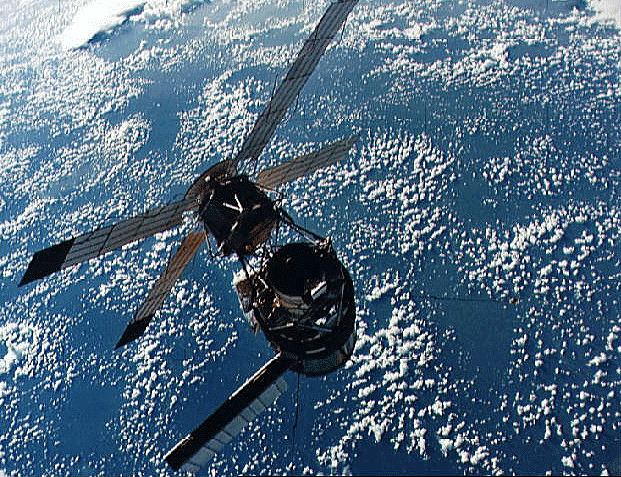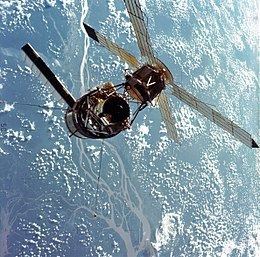COSPAR ID 1973-050A Orbits completed 858 Period 1.6 hours Launch date 28 July 1973 Landing date 25 September 1973 | SATCAT no. 6757 Spacecraft Apollo CSM-117 Apogee 441,000 m Dates 28 Jul 1973 – 25 Sep 1973 | |
 | ||
Mission duration 59 days, 11 hours, 09 minutes, 01 seconds Distance travelled 39,400,000 kilometers (24,500,000 mi) Members Alan Bean, Owen K. Garriott, Jack R. Lousma | ||
Nasa skylab 3 mission report 71902
Skylab 3 (also SL-3 and SLM-2) was the second manned mission to the first American space station, Skylab. The mission began July 28, 1973, with the launch of three astronauts on the Saturn IB rocket, and lasted 59 days, 11 hours and 9 minutes. A total of 1,084.7 astronaut-utilization hours were tallied by the Skylab 3 crew performing scientific experiments in the areas of medical activities, solar observations, Earth resources, and other experiments.
Contents
- Nasa skylab 3 mission report 71902
- 1973 skylab 3 nasa
- Support crew
- Mission parameters
- Docking
- Space walks
- Mission highlights
- Mission insignia
- Spacecraft location
- References

The manned Skylab missions were officially designated Skylab 2, 3, and 4. Mis-communication about the numbering resulted in the mission emblems reading Skylab I, Skylab II, and Skylab 3 respectively.

1973 skylab 3 nasa
Support crew
Mission parameters

Docking
Space walks
Mission highlights
During the approach phase, a propellant leak developed in one of the Apollo Service Module's reaction control system thruster quads. The crew was able to safely dock with Skylab, but troubleshooting continued with the problem. Six days later, another thruster quad developed a leak, creating concern amongst Mission Control. For the first time, an Apollo spacecraft would be rolled out to Launch Complex 39 for a rescue mission, made possible by the ability for the station to have two Apollo CSMs docked at the same time. It was eventually determined that the CSM could be safely maneuvered using only two working thruster quads, and the rescue mission was never launched.
The crew, during their first EVA, installed the twin-pole sunshade, one of the two solutions for the destruction of the micrometeoroid shield during Skylab's launch to keep the space station cool. It was installed over the parasol, which was originally deployed through a porthole airlock during Skylab 2. Both were brought to the station by Skylab 2.
Skylab 3 continued a comprehensive medical research program that extended the data on human physiological adaptation and readaptation to space flight collected on the previous Skylab 2 mission. In addition, Skylab 3 extended the astronauts' stay in space from approximately one month to two months. Therefore, the effects of flight duration on physiological adaptation and readaptation could be examined.
A set of core medical investigations were performed on all three Skylab manned missions. These core investigations were the same basic investigations that were performed on Skylab 2, except that the Skylab 3 inflight tests were supplemented with extra tests based on what researchers learned from the Skylab 2 science results. For example, only leg volume measurements, preflight and postflight stereophotogrammetry, and in-flight maximum calf girth measurements were originally scheduled for all three Skylab missions.
In-flight photographs from Skylab 2 revealed the "puffy face syndrome" which prompted the addition of in-flight torso and limb girth measurements to gather more data on the apparent headward fluid shift on Skylab 3. Other additional tests included arterial blood flow measurements by an occlusive cuff placed around the leg, facial photographs taken before flight and during flight to study the "puffy face syndrome", venous compliance, hemoglobin, urine specific gravity, and urine mass measurements. These inflight tests gave additional information about fluid distribution and fluid balance to get a better understanding of the fluid shift phenomena.
The Skylab 3 biological experiments studied the effects of microgravity on mice, fruit flies, single cells and cell culture media. Human lung cells were flown to examine the biochemical characteristics of cell cultures in the microgravity environment. The two animal experiments were entitled Chronobiology of Pocket Mice and Circadian Rhythm in Vinegar Gnats. Both experiments were unsuccessful due to a power failure 30 hours after launch, which killed the animals.
High school students from across the United States participated in the Skylab missions as the primary investigators of experiments that studied astronomy, physics, and fundamental biology. The student experiments performed on Skylab 3 included the study of libration clouds, X-rays from Jupiter, in-vitro immunology, spider web formation, cytoplasmic streaming, mass measurement, and neutron analysis.
The crew's health was assessed on Skylab by collecting data on dental health, environmental and crew microbiology, radiation, and toxicological aspects of the Skylab orbital workshop. Other assessments were made of astronaut maneuvering equipment and of the habitability of the crew quarters, and crew activities/maintenance experiments were examined on Skylab 2 through 4 to better understand the living and working aspects of life in space.
Mission insignia
The circular crew patch was Leonardo da Vinci's Vitruvian Man, representing the mission's medical experiments and retouched to remove the genitalia. In the background is a disk that is half-sun (including sunspots) and half earth to represent the experiments done on the flight. The patch has a white background, the crew's names and "Skylab II" with a red, white and blue border. The wives of the crew secretly had an alternate graphic made of a 'universal woman' with their first names in place of the crew's. Stickers with this on them were put in lockers aboard the Command Module to surprise the crew.
Spacecraft location
The Apollo Command Module used on Skylab 3 is currently on display at the visitor's center of the NASA Glenn Research Center at the Great Lakes Science Center in Cleveland, Ohio.
The module used to be at Glenn visitor center, and was moved to the Great Lakes Science Center in June 2010. It took a year to plan and 120,000 USD to move the capusle.
